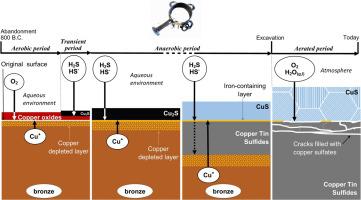当前位置:
X-MOL 学术
›
Corros. Sci.
›
论文详情
Our official English website, www.x-mol.net, welcomes your
feedback! (Note: you will need to create a separate account there.)
Remarkable corrosion resumption of archaeological bronzes, induced by the oxidation of ternary Cu-Sn-S phases in atmosphere, after long-term burial with sulfides
Corrosion Science ( IF 7.4 ) Pub Date : 2020-10-01 , DOI: 10.1016/j.corsci.2020.108865 Céline Rémazeilles , Véronique Langlet-Marzloff , Juan Creus , Guillaume Lotte , Christophe Deshayes , François Baleux , Luc Robbiola
Corrosion Science ( IF 7.4 ) Pub Date : 2020-10-01 , DOI: 10.1016/j.corsci.2020.108865 Céline Rémazeilles , Véronique Langlet-Marzloff , Juan Creus , Guillaume Lotte , Christophe Deshayes , François Baleux , Luc Robbiola

|
Abstract A drastic alteration resumption observed on archaeological bronze objects was investigated, characterized by crystals growing under the surface of the objects, inducing cracks, desquamation and detachment of patina scales. Analyses shown that artefacts were covered by a thick layer of covellite CuS, which proved to be air-stable. On the contrary, Cu-Sn-S compounds (mohite and kuramite), replacing the alloy in the bulk, showed an extreme reactivity towards air and a rapid transformation into hydrated copper sulfates. This phenomenon was unknown in the restoration field and an overall alteration process, from abandonment until exhibition, implying occurrence mechanisms of alteration products, is proposed.
中文翻译:

在用硫化物长期掩埋后,由大气中三元 Cu-Sn-S 相氧化引起的考古青铜显着恢复腐蚀
摘要 研究了考古青铜器上观察到的剧烈蚀变恢复现象,其特征是在器物表面下生长晶体,引起裂纹、脱屑和铜锈鳞片脱落。分析表明,人工制品被一层厚厚的 covellite CuS 覆盖,这被证明是空气稳定的。相反,Cu-Sn-S 化合物(钼铁矿和库拉铁矿)在整体上取代合金,表现出对空气的极端反应性并迅速转变为水合硫酸铜。这种现象在修复领域是未知的,提出了从废弃到展出的整体改造过程,暗示了改造产品的发生机制。
更新日期:2020-10-01
中文翻译:

在用硫化物长期掩埋后,由大气中三元 Cu-Sn-S 相氧化引起的考古青铜显着恢复腐蚀
摘要 研究了考古青铜器上观察到的剧烈蚀变恢复现象,其特征是在器物表面下生长晶体,引起裂纹、脱屑和铜锈鳞片脱落。分析表明,人工制品被一层厚厚的 covellite CuS 覆盖,这被证明是空气稳定的。相反,Cu-Sn-S 化合物(钼铁矿和库拉铁矿)在整体上取代合金,表现出对空气的极端反应性并迅速转变为水合硫酸铜。这种现象在修复领域是未知的,提出了从废弃到展出的整体改造过程,暗示了改造产品的发生机制。











































 京公网安备 11010802027423号
京公网安备 11010802027423号